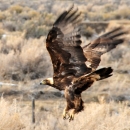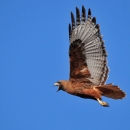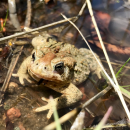Visit Us
Hutton Lake National Wildlife Refuge supports hosts some visitors over the course of a year, mostly from March through October. Wildlife-viewing opportunities and refuge access is limited from November through February due to frozen ponds and cold, snowy weather.
Activities
Hiking, bird watching and wildlife watching has previously been the most common activity on Hutton Lake National Wildlife Refuge. Recently the refuge was opened to allow some hunting as well. The close proximity to the city of Laramie makes this a popular place for locals to get out and enjoy the outdoors.
Trails
Hutton Lake National Wildlife Refuge offers public access to 2.6 miles of hiking trail. It is possible to hike all or portions of the system. The flat to gently sloping terrain makes it enjoyable for all hikers.
The trail begins at the entrance gate parking area, loops to the shore of Creighton Lake, before heading off toward Lake George. There you will find a photography blind built by an Eagle Scout Candidate in 2013. Walk past the blind to the south side of Lake George and continue on to the northwest edge of Rush Lake before turning onto the dam between Rush and Hutton Lakes. At the northeast end of the dam is a roadway which takes you back to the trail by Creighton. You can either walk back on the roadway to the entrance, or take the Creighton portion of the trail back to your vehicle. There is also a short spur trail from the Rush/Hoge dam to the water control structure between Hoge and Hutton Lakes. This trail can also be accessed at the Lake George parking lot and the Rush Lake parking lot for those that want a shorter hike.
Related Documents
Wetlands of Hutton Lake NWR (from CCP)
Hutton Lake NWR consists of five impoundments and surrounding uplands immediately adjacent to the floodplain of the Laramie River southwest of Laramie. Originally, there were likely only three separate basins—what is now Creighton Lake, Lake George, and Hutton Lake. Dikes were constructed to create Rush and Hoge lakes, and along the west boundary of the refuge, in an apparent attempt to keep water from reaching the floodplain to the west. A diversion structure was also placed in Sand Creek to move appropriated water from the creek to the refuge, and ditches were dug to connect Rush and Creighton lakes and Lake George for easier water movement between them.
Creighton Lake (210 surface acres or 2,525 acre-feet) and Hutton Lake (221 surface acres or 1,135 acre-feet) are large and fairly deep open water areas with no water management capabilities once water reaches them. They typically fluctuate between various water levels based on yearly water availability and evaporation, rarely being completely full or dry. The fluctuating water levels prevent the establishment of emergent vegetation on these two wetlands by either drying up or flooding out any plants that might try to take hold.
Lake George, a smaller natural basin (16 surface acres or 250 acre-feet), receives water more often and more reliably than the larger pools. It maintains a water level stable enough for the establishment of a hardstem bulrush ring that completely encircles the lake.
Rush and Hoge lakes are larger than Lake George, but shallower and smaller than Hutton and Creighton lakes. Rush Lake (95 surface acres or 250 acre-feet) is the first in the system to receive water, so it generally benefits from available water from Sand Creek. It is also the shallowest pool and tends to dry up the quickest when water ceases to be available for recharge. Over 50 percent of Rush lake is emergent vegetation—hardstem bulrush and cattail—with numerous smaller areas of open water, and historic ditches through the lake to aid water movement to Hoge Lake and Lake George. Hoge Lake (75 surface acres or 200 acre-feet) has open water through its middle with significant stands of hardstem bulrush along the dike between it and Rush Lake and in the bay on its south side. Submergent vegetation is found in all pools but not in large amounts.
Creighton and Hutton lakes are important resting areas for waterfowl in the spring and fall, as rafts of redheads, scaup, canvasback, and coots numbering in the thousands are not uncommon. Canada geese use these lakes as molting areas in the summer. George Lake and Hoge and Rush lakes provide nesting habitat for coots, ruddy ducks, blackbirds, marsh wrens, pied-billed grebes, and soras, as well as feeding habitat for coots and dabbling ducks. Rush Lake also provides nesting habitat for whitefaced ibis and black-crowned night-herons. Water levels are generally low enough on Creighton and Hutton lakes to allow nesting by American avocets and killdeer, but the lakes can potentially flood in high-water years.
During the summers of 2004 and 2005, California gull and double-crested cormorant rookery were established along the north shore of Hutton Lake. This previously unobserved activity occurred below the high waterline of the lake, and it is unknown whether nesting would occur under high water conditions.
From the time of its establishment to present, the lack of senior water rights for Hutton Lake NWR has been an issue. In the semiarid Laramie Basin, water is a key resource to manage habitat for the benefit of migratory bird species. The refuge owns junior water rights, which means the refuge wetlands water levels are dependent on natural processes and the willingness of neighbors with senior water rights from Sand Creek to share their water. Records from the 1970s indicate low water availability, this trend of low water is prevalent through the 1970s until 1979 and 1980, which were reportedly good water years. By 1981 water conditions were again reported as poor. Since the 1980s, water control structures at the refuge have remained in place with no manipulation of the boards or screw gates to actively manage water levels (Pam Johnson, wildlife biologist, Arapaho NWR; personal communication, January 2007). Water levels must be high in Rush and Hoge lakes and Lake George before water can move to the other wetlands. A water diversion structure on Sand Creek is regulated by the Wyoming Water Commissioner. From Rush Lake, water can flow to Lake George or Hoge Lake, or both. Lake George connects to the largest lake (Creighton Lake), and Hoge Lake connects to Hutton Lake.
Uplands of Hutton Lake NWR
Uplands range from the shorelines of Hutton and Creighton lakes up to the highest benches, approximately 100 feet above the lakes. Soil characteristics result in some vegetative variability. The relatively flat area between the lakes is dominated by a large prairie dog town. This area is sparsely vegetated, with few grasses, several types of annual weeds and forbs, prickly pear, and greasewood on the south. In general, the southern uplands are more grass dominated and the north holds a little more greasewood, but openings in the brush and greasewood plants can be found throughout the refuge. The greasewood plants are especially thick and tall (4–5 feet) northeast of Creighton Lake, east of Hutton Lake, and along the spoil piles northeast of Hoge and Rush lakes. An area in the southwest corner of the refuge has been irrigated in the past and holds a thicker, more grass dominated regime than the rest of the refuge uplands. Vegetative species include western and bluebunch wheatgrass, needle and thread, and rabbitbrush.
Irrigated Meadows of Hutton Lake NWR
The meadows on Hutton Lake NWR are within the floodplain of Sand Creek and likely were historically flooded seasonally during runoff. The diversion structure on Sand Creek that brings water into the refuge is in this area. When the structure is open or if the neighbor is irrigating the adjacent ground, this area is flooded—sometimes for extended periods— depending on water availability.
Other Facilities in the Complex
Hutton Lake National Wildlife Refuge is managed as part of the Central Sage Steppe Conservation Complex. A Conservation Complex is a group of two or more refuges, wildlife management areas, wetland management districts, or conservation areas that are primarily managed from a central office location. Refuges are grouped into a complex because they occur in a similar region, such as a watershed or specific habitat type, and have a related purpose and management needs. Typically, a project leader oversees the management of the refuges within the complex and refuge managers are responsible for operations at specific refuges. Support staff: administrative, law enforcement, refuge manager, biological, fire, visitor services, and maintenance, are centrally located and help with all refuges within the complex.
Other refuges in the Central Sage Steppe Conservation Complex include: Arapaho National Wildlife Refuge (Walden, Colorado); Pathfinder National Wildlife Refuge (Alcova, Wyoming); Bamforth National Wildlife Refuge, Mortenson Lake National Wildlife Refuge, and the Wyoming Toad Conservation Area (Laramie, Wyoming); as well as Seedskadee National Wildlife Refuge (Green River, Wyoming), Cokeville Meadows National Wildlife Refuge (Cokeville, Wyoming), and Wyoming's portion of the Bear River Watershed Conservation Area. Administrative headquarters for Arapaho, Pathfinder, and the Laramie Plains refuges is located at Arapaho National Wildlife Refuge, in Walden, Colorado phone number 970-732-8202, while administrative headquarters for the southwestern Wyoming refuges is located at Seedskadee National Wildlife Refuge, 37 miles north of Green River on Hwy 372 - 246 Seedskadee Road, PO Box 700, Green River, WY 82935; phone number 307-875-2187.
Rules and Policies
Visiting Hours: The refuge is open daily from 1/2 hour before sunrise to 1/2 hour after sunset.
Access and Parking: Motor vehicles are permitted on improved refuge roads only. Roads marked as "Closed" or "Authorized Vehicles Only" are closed to the public. If the gate at the entrance parking area is shut, the road is closed to vehicular traffic, but is open to walk-in access unless otherwise posted. Parking is permitted in designated parking areas only. Overnight RV parking is prohibited. Note that the condition and closure of public roads are subject to seasonal and weather-related factors.
ATVs and Snowmobiles: ATVs and snowmobiles may not be used on any portion of the refuge.
Hunting and Fishing: Please see the Hunting and Fishing section for details, some hunting is allowed but no fishing.
Hiking: Hiking and walking are only allowed on established roads open to vehicular traffic and designated trails. Roads marked as "Closed" or "Authorized Vehicles Only" are closed to the public. If the gate at the entrance parking area is shut, the road is closed to vehicular traffic, but is open to walk-in access unless otherwise posted.
Boating: The use of boats and canoes is not allowed on the refuge.
Bicycling: Bicycling is permitted on the refuge, but is restricted to established roads open to vehicular traffic. Roads marked as "Closed" or "Authorized Vehicles Only" are closed to bicycling. Bicycles are prohibited on hiking trails.
Camping: Camping is prohibited anywhere on the refuge, including overnight parking. All visitors must leave the refuge at the end of each day.
Horseback Riding: Horseback riding is prohibited on the refuge.
Fires: No fires of any type are permitted within the refuge.
Littering: Littering is prohibited on the refuge. Please carry out all trash from the refuge.
Picnicking: There are no public picnic facilities located on the refuge.
Firearms: Persons possessing, transporting, or carrying firearms on National Wildlife Refuge System lands must comply with all provisions of State and local law. Persons may only use (discharge) firearms in accordance with refuge regulations (50 CFR 27.42 and specific refuge regulations in 50 CFR Part 32). Discharge of a firearm for any reason other than the legal taking of game animals is prohibited.
Pets: All pets must be leashed.
Disturbance of Animal or Plant Life: Molesting, injuring, disturbing, or destroying any animal or plant, except properly taken game in-season, is prohibited.
Disturbance of Artifacts and Historic Items: Artifacts and historic items are protected on refuge lands by Federal law. It is unlawful to search for or remove these objects from refuge lands.
Shed Hunting: Shed hunting is not permitted on any portion of the refuge.
Personal Conduct: Disorderly conduct is forbidden at all times. Anyone who is obviously intoxicated will not be allowed to remain on the refuge.
If you have any questions about rules and regulations or law enforcement on the refuge, please feel free to stop by headquarters, call staff at 970-723-8202 or email: arapaho@fws.gov
Locations
Directions to Hutton Lake NWR: From Laramie, take Wyoming Highway 230E for 12 miles (near mile marker 12). Turn left onto Brubaker Lane (Albany County 37), and continue for 6.7 miles. You will arrive at a T-intersection which is Sand Creek Road. Turn left onto Sand Creek Road and continue for 4.5 miles. Turn left onto Hutton Lakes Road and continue for .5 miles to the Refuge entrance sign.







